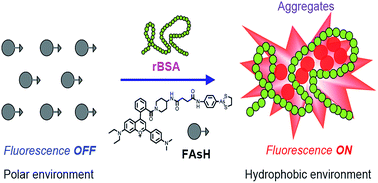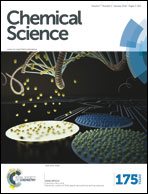Development of a red fluorescent light-up probe for highly selective and sensitive detection of vicinal dithiol-containing proteins in living cells†
Abstract
Vicinal dithiol-containing proteins (VDPs) play a key role in cellular redox homeostasis and are responsible for many diseases. Here, we develop a red fluorescent light-up probe FAsH for the highly selective and sensitive detection of VDPs using the environment-sensitive 2-(4-dimethylaminophenyl)-4-(2-carboxyphenyl)-7-diethylamino-1-benzopyrylium (F1) as the fluorescent reporter and cyclic dithiaarsane as the targeting unit. FAsH is almost nonfluorescent in aqueous solution. However, it exhibits intense fluorescence emission upon binding to reduced bovine serum albumin (rBSA, selected as the model protein). The fluorescence intensity of FAsH is directly proportional to the concentration of rBSA over the range of 0.06–0.9 μM, with a detection limit (3δ) of 0.015 μM. Importantly, the fast kinetics of binding between FAsH and VDPs (∼2.5 min) enables the dynamic tracing of VDPs in biological systems. Preliminary experiments show that FAsH can be used for the no-wash imaging of endogenous VDPs in living cells. In addition, our study shows that F1 presents both high environment-sensitivity and good fluorescence properties, and is promising for the development of no-wash fluorescent light-up probes for target-specific proteins in living cells.


 Please wait while we load your content...
Please wait while we load your content...